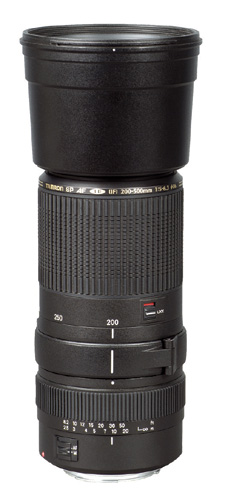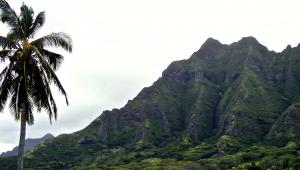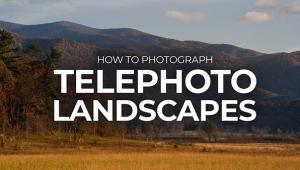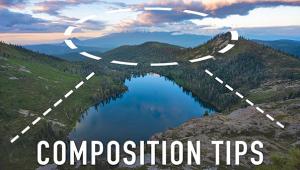Digitally Optimized Zoom Lenses; Do They Really Make A Difference? Page 2
Longer Tamron Di Zooms
At the time of this writing, Tamron's Di series includes six lenses, ranging
in focal length from 17-500mm. I have previously tested three of them: the 28-75mm
f/2.8 and 180mm f/3.5 Macro (November 2003 issue) and the 17-35mm f/2.8-4 (August
2004 issue). The full reviews are also available at www.shutterbug.com, easily
found using the Search function. Much shorter Di zooms may be introduced in
future, but for now, the company is working on expanding their Di II series.
Those lenses were designed exclusively for digital SLRs with APS-C size sensors
and are not discussed in this report.
Tamron AF28-300 mm f/3.5-6.3 XR Di LD Aspherical (IF) Macro: Designed
to cover 90 percent of the most popular focal lengths, this zoom scores an A
in versatility. Because it can replace several other lenses, it also provides
excellent value. Although nearly identical in (modest) size and weight to its
best-selling predecessor, this Di model incorporates more of the high-tech optical
elements described earlier.
According to Tamron, the upgrade to the Di standard was intended to provide
two primary benefits: better optical performance at long focal lengths and higher
contrast in digital capture. In the 28-200mm range, I would happily shoot all
day at f/5.6 but edge sharpness does increase at f/8. At the longer focal lengths,
it's worth stopping down to f/11 for the best overall image quality. That
may call for ISO 200 or ISO 400 for fast shutter speeds to prevent blur from
camera shake. It's also worth boosting contrast a bit, with in camera
controls or during post-processing.
Tamron SP AF200-500mm f/5-6.3 Di LD (IF): A worthy successor to the
200-400mm f/5.6 SP model, this longer Di telephoto packs incredible power for
a compact, lightweight, and relatively affordable zoom. Granted, it requires
86mm filters and those (especially circular polarizers) are pricey. This is
a sturdy lens, with a solid tripod mounting collar and a very long/deep hood
for effective flare control. It also includes the new Filter Effects Control
Ring that allows for rotating a polarizer while the lens hood is in place. Designed
to provide superior correction of color aberrations (with two low dispersion
elements), it's also optimized for digital capture with higher resolution,
greater internal flare control, and reduced peripheral light falloff.
 |
|
|
Note: As with any telephoto lens, use a rigid, sturdy tripod
to maximize the optical potential of this long zoom. When shooting handheld,
or in action photography, use very fast shutter speeds to prevent blur from
camera or subject movement. That's particularly important when using a
digital SLR that increases the effective focal length by at least 1.5x; any
blurring from camera or subject movement is equally magnified. In handheld shooting
with an EOS 20D, I needed to use a shutter speed of at least 1/1000 sec at the
500mm end (800mm equivalent) for sharp images. Because the maximum aperture
is quite small at long focal lengths, that required ISO 400 on sunny days or
ISO 800 when shooting at small apertures for the very best optical performance.
In the 200-300mm range, this zoom delivered images with high center sharpness
and good edge sharpness even at f/5.6. When shooting in the 310-400mm range,
I got similar results at f/8. At longer zoom settings, wide aperture photos
exhibit good central sharpness; that's fine, because most photographers
tend to center their subjects when using any super telephoto lens. For higher
resolution, across the entire frame, it's worth stopping down to f/10.
For snappy contrast--especially in flat, cloudy day lighting--use
a contrasty film or the options available in digital capture. Although not intended
for professionals, this would be a suitable lens for sports and wildlife photo
enthusiasts who want frame-filling shots of distant subjects and plan to make
beautiful 8.5x11" prints.
 |
|
|
Technical Specifications
Lens: Sigma 12-24mm f/4.5-5.6 EX DG Aspherical
Construction (Elements/Groups): 16 in 12; includes SLD and AL elements
Equivalent Focal Length: 18-36mm or 19.2-38.4mm or 20.4-40.8mm
Min. Focus/Max. Magnification: 11"; 1:7.1
Filter Size: Rear only (gelatin insert)
Dimensions and Weight: 3.4x3.9"; 21.6 oz
Notes: Internal focusing; built-in hood; ultra-sonic HSM focus in C,
N, and S mounts
Available Mounts: Canon, Minolta Nikon, Pentax, Sigma AF
Street Price: $699
 |
|
|
Lens: Sigma 17-35mm f/2.8-4 EX DG Aspherical
Construction (Elements/Groups): 16 in 13; includes SLD and AL elements
Equivalent Focal Length: 25.5-52.5mm or 27.2-56mm or 28-9-59.5mm
Min. Focus/Max. Magnification: 10.6"; 1:4.5
Filter Size: 77mm
Dimensions and Weight: 3.3x3.4"; 19.8 oz
Notes: As above but hood is detachable
Available Mounts: Canon, Minolta, Nikon, Pentax, Sigma
Street Price: $469
 |
|
|
Lens: Tamron AF28-300mm f/3.5-6.3 XR Di LD Aspherical (IF)
Macro
Construction (Elements/Groups): 15 in 13; includes XR, LD, AL, and
AD element
Equivalent Focal Length: 32-450mm or 45-480mm
Min. Focus/Max. Magnification: 19.3"; 1:2.9
Filter Size: 62mm
Dimensions and Weight: 3.3x2.9; 14.8 oz
Notes: Internal focusing; hood included
Available Mounts: Canon, Minolta, Nikon, Pentax
Street Price: $399
 |
|
|
Lens: Tamron SP AF200-500mm f/5-6.3 Di LD (IF)
Construction (Elements/Groups): 13 in 10; includes LD elements
Equivalent Focal Length: 300-750mm or 320-800mm
Min. Focus/Max. Magnification: 8.2 ft; 1:5
Filter Size: 86mm
Dimensions and Weight: 8.9x3.7"; 43.6 oz
Notes: As above plus filter effects control ring
Available Mounts: Canon, Minolta, Nikon
Street Price: $875
*Note: The focal length magnification factor depends on the exact APS-C sensor size. It's 1.5x with Nikon, Fuji, and Pentax digital SLRs; 1.6x with most digital EOS models; and 1.7x with Sigma's SD cameras. The data provided does not apply to digital SLRs with larger sensors or to 35mm cameras.

A long-time "Shutterbug" contributor, stock photographer Peter K. Burian is the author of two recent books: "Magic Lantern Guide to the Konica Minolta Maxxum 7D" (Lark Books) and "Mastering Digital Photography and Imaging" (Sybex).
- Log in or register to post comments

































